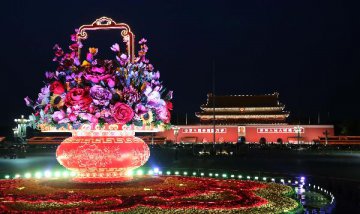
China's local governments were busy making and releasing detailed measures to implement supply-side structural reform when an "authority figure" called the reform "a battle we cannot afford to lose." Shanghai unveiled 27 major tasks on Tuesday with a focus on advanced industrial equipment, information technology, new materials and supply of daily consumer goods. "The city will do more to increase supplies," said Chen Mingbo, director of Shanghai Municipal Commission of Economy and Informatization.
Shanghai is the latest of more than a third of China's 31 provincial-level regions to release supply-side reform plans with measures to cut overcapacity, reduce stockpiles, de-lever, lower business costs and fix shortcomings. "The People's Daily" ran an interview with an "authoritative figure" on Monday, saying that government work should center around supply-side structural reform currently and in the future.
"In the long run, the reform is a lifeline for us in avoiding the middle-income trap. It is a battle we cannot afford to lose," said the authoritative figure, a term usually reserved for the highest-ranking officials. "Supply-side structural reform must be strengthened," said the unnamed source.
The central leadership is counting on the reform to address economic woes in anticipation that the economy will tend towards L-shaped growth as deep-rooted problems persist and new challenges emerge. Overcapacity reduction will continue and "zombie" enterprises will be closed, according to the article.
"Investment expansion must be proper, rather than excessive," said the article, rejecting short-term debt-based stimuli. The People's Bank of China, the central bank, said last week in a quarterly report that it will create a "neutral and appropriate" monetary environment for supply-side reform. "This round of easy monetary policy from 2014 to 2015 may be coming to an end," said Deng Haiqing, chief economist with brokerage firm JZ Securities.
Some measures have kicked in. In the first quarter of 2016, production of steel and coal dropped 3.2 percent and 5.3 percent year on year, respectively.
Officials in Hebei Province, a major steel production base with China's worst air pollution, will face immediate removal from their posts if new steel mills are built or closed factories reopen. With the phasing out of excess capacity, factory profits have rebounded.
Profits of major industrial enterprises rose 11.1 percent in March, up from 4.8-percent growth in January and February. "The preliminary effects of supply-side structural reform emerged in the first quarter," said Ning Jizhe, head of the National Bureau of Statistics.
In Q1, new market entity registrations increased 10.7 percent, thanks to a setup process reduced from an average of 26 days to just three days. "China has become the world's second largest country of entrepreneurship," said Lin Nianxiu, vice head of the National Development and Reform Commission, adding that more pro-entrepreneurship measures were in the pipeline.
The service sector also grew strongly, contributing 56.9 percent of GDP in Q1, up from 54.9 percent in the same period last year. In a sign of a robust service sector, China's box office sales rose 48.7 percent and the number of moviegoers was up by 51.1 percent. Imax CEO Richard Gelfond predicted that China will overtake the United States as the world's largest movie market in 2017.
Supply-side reform is aimed at improved agricultural, industrial and service sectors, less red tape, stronger R&D and a freer flow of resources, according to Yu Bin, a senior macroeconomic researcher with the Development Research Center of the State Council, an official think tank. "Implementing reforms is key to the future of China's economy," said Yu.



















Latest comments